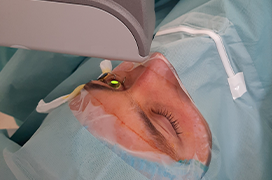Aim: To evaluate the long-term impact of accelerated corneal cross-linking (A-CXL) on selected refractive and topographical parameters in eyes with progressive keratoconus.
Methods: 77 eyes with keratoconus in 54 patients treated with A-CXL (10 min "epi-off" protocol) were included in the analysis. Preoperative and postoperative (1, 3 and 5 years after A-CXL) values of the studied parameters were compared.
Results: In the cohort, there was an improvement in best corrected central visual acuity (BCCVA) 1 year (p = 0.004) and 3 years (p < 0.001) after A-CXL. Values of cylindrical component of refraction (Dcyl) (p = 0.043; p = 0.009; p = 0.063), maximum anterior corneal surface curvature (Kmax) (p = 0.003; p < 0.001; p ˂ 0.001), Coma aberration (p = 0.023; p ˂ 0.001; p = 0.005) and minimum corneal thickness (Pachymin) (p ˂ 0.001; p = 0.003; p = 0.034) were reduced at 1 year, 3 years and 5 years after surgery. The value of the steepest meridian of the anterior corneal surface (K1) was reduced only at 3 years and 5 years after surgery (p = 0.007; p = 0.012). In the year-to-year comparison 1 year vs. 3 years after surgery, there was a continued improvement in K1 (p = 0.024), the flattest meridian of the anterior corneal surface (K2) (p = 0.012), Kmax (p = 0.001) and Coma (p ˂ 0.001) values, and this also applied 1 year vs. 5 years after A-CXL in the case of Kmax (p = 0.001) and Coma (p = 0.049). We confirmed that the younger the patient at the time of A-CXL, the more pronounced the decline in Kmax at the 3-year interval after the procedure. Furthermore, we observed a significant correlation between the maximum preoperative anterior corneal surface curvature (Kmax_0) and the change in the DCyl parameter 1 and 3 years after A-CXL, as well as between Kmax_0 and the postoperative decrease in Kmax 5 years after surgery.
Conclusion: In the cohort, there was a favorable change in most of the analyzed parameters (BCCVA, Dcyl, K1, K2, Kmax, Coma, and Pachymin) and a trend towards a further decrease in K1, K2, Kmax, and Coma values at 3 years, and subsequently in Kmax and Coma at 5 years after surgery, was confirmed.

